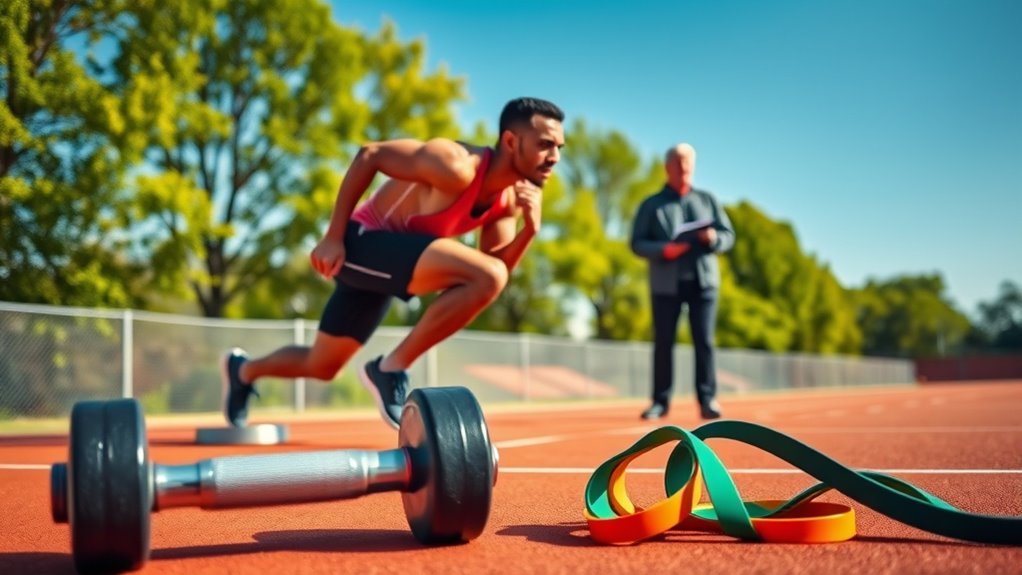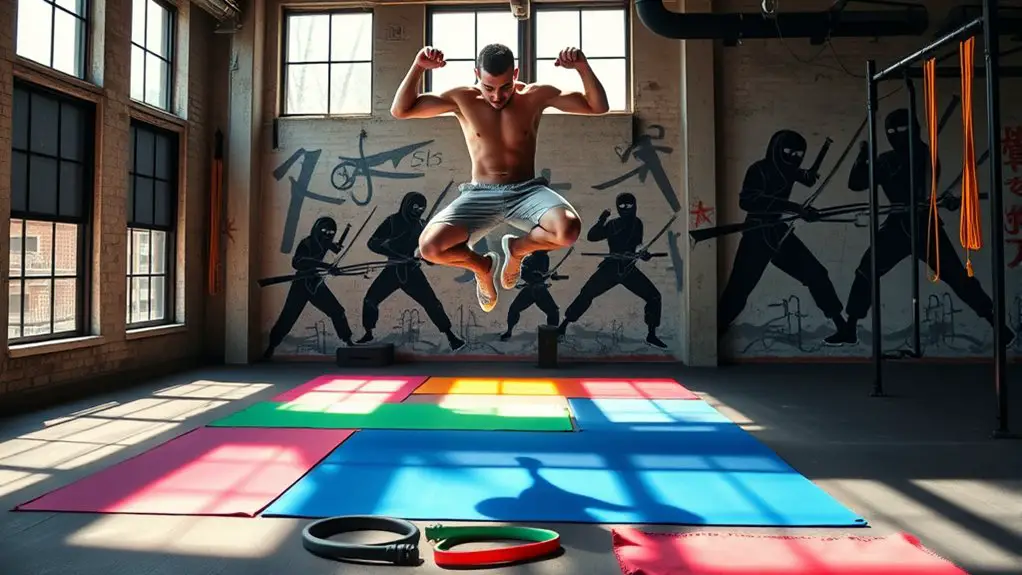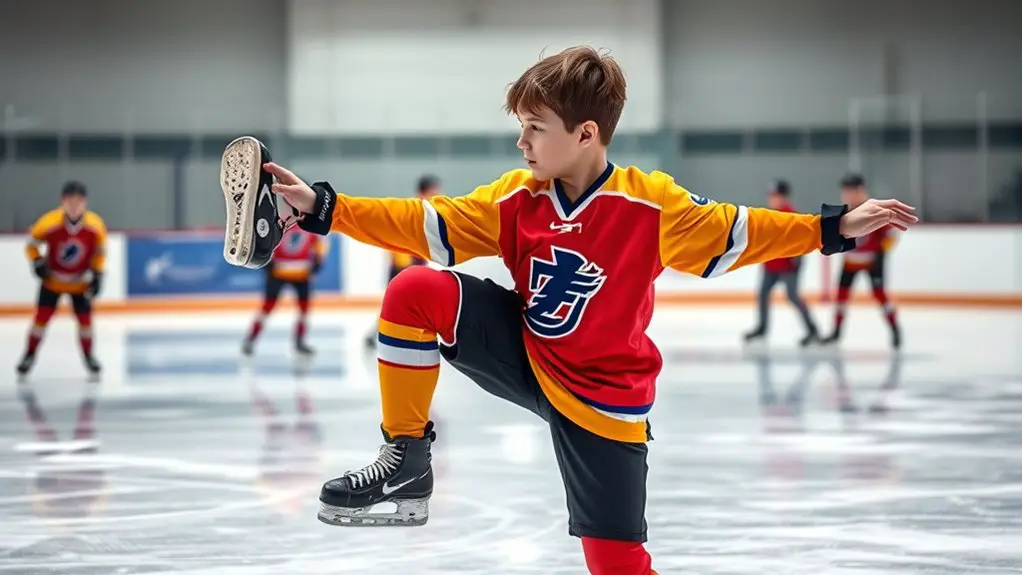To boost your baseball performance, focus on core workouts like plank variations, medicine ball rotational throws, and cable woodchoppers. Planks improve stability, while rotational throws mimic important twisting motions. Incorporate dead bugs for coordination and Russian twists for oblique strength. Don't forget stability ball exercises to engage your core fully. Aim for two to three sessions a week, integrating these moves into your routine. There's more to explore on enhancing your core strength effectively!
Understanding the Importance of Core Strength in Baseball
When you think about what makes a great baseball player, you might focus on skills like hitting or pitching, but the truth is that core strength plays an essential role in your overall performance. Your core muscles stabilize your body, allowing you to generate power in your swings and throws. When your core's strong, you can maintain better balance and control, which means more accurate pitches and powerful hits. It's not just about brute strength; it's about the ability to transfer energy effectively through your body. A strong core helps you withstand the rigors of the game, reducing the risk of injuries that can sideline you. Plus, having good core stability enhances your agility, making you quicker on your feet. Ultimately, investing time in core workouts can elevate your game, giving you the freedom to play at your best and enjoy the sport you love. Furthermore, a strong core stabilizes the body during exertion, which is crucial for performing at peak levels in baseball.
Plank Variations for Stability
Core strength is foundational for baseball players, and one of the best ways to build that strength is through plank variations. These exercises not only improve stability but also enhance your overall performance on the field. Start with the classic plank: hold your body straight, supported on your forearms and toes. This position engages your core, shoulders, and back.
Once you're comfortable, try side planks for added challenge. Balancing on one arm, you'll activate your obliques and improve lateral stability, essential for quick movements during games. For an extra twist, incorporate plank jacks—jumping your feet in and out while maintaining your plank position.
Don't forget about the forearm plank to reach out with one arm, alternating sides to build stability and control. These variations not only strengthen your core but also give you the freedom to move confidently and powerfully on the diamond. Incorporating core engagement from exercises like deadlifts can further enhance your overall athletic performance and injury prevention.
Medicine Ball Rotational Throws
Release your power with medicine ball rotational throws, a dynamic exercise that enhances your core strength and rotational speed. This movement mimics the explosive twisting required in baseball, helping you achieve that perfect swing or pitch. To start, stand with your feet shoulder-width apart, holding a medicine ball at your chest. Rotate your torso to one side, then explosively throw the ball against a wall or to a partner while pivoting your back foot.
Focus on using your core, not just your arms, to generate power. Engage your abs and obliques as you throw, and don't forget to follow through. Incorporating compound movements into your training can further enhance your overall strength and athletic performance.
Perform three sets of 10-15 throws on each side, allowing your body to feel the freedom and strength that comes with each rotation. Incorporate this exercise into your routine and watch your performance on the field soar as you harness your core's full potential.
Cable Woodchoppers for Power
Building on the explosive movements from medicine ball rotational throws, cable woodchoppers take your core training a step further by targeting your obliques and improving your rotational power. This exercise allows you to harness the freedom of movement, replicating the dynamic twists required in baseball.
To perform cable woodchoppers, set the cable at shoulder height and stand side-on to the machine. Grab the handle with both hands, and with a strong stance, pull the cable diagonally across your body, pivoting your hips and engaging your core. Control the movement as you return to the starting position.
Integrating this exercise into your routine not only builds strength but also enhances your ability to generate power during swings and throws. You'll feel more agile and explosive, which translates directly to better performance on the field. Additionally, focusing on joint health is crucial for optimizing your athletic performance and preventing injuries. Embrace this powerful workout, and release your true potential!
Dead Bug Exercise for Coordination
Although it may seem simple, the Dead Bug exercise is a fantastic way to improve coordination and stability, which are crucial for baseball players. By engaging your core while moving your limbs, you'll enhance your body awareness and control, essential for those quick movements on the field. Moreover, effective mobility training can significantly reduce injury risk and contribute to your overall performance.
To perform the Dead Bug exercise effectively, keep these tips in mind:
- Start Position: Lie on your back with your arms extended toward the ceiling and knees bent at 90 degrees.
- Movement: Slowly lower one arm and the opposite leg toward the ground, keeping your lower back pressed into the floor.
- Breathing: Exhale as you move your limbs, and inhale as you return to the starting position.
- Repetitions: Aim for 10-15 reps on each side to build endurance and coordination.
Incorporating the Dead Bug into your routine can help you achieve the freedom of movement you crave in baseball!
Russian Twists for Oblique Strength
If you want to enhance your oblique strength, incorporating Russian Twists into your workout routine is a must. This exercise targets your side muscles, helping you develop the rotational power essential for hitting and throwing. To perform a Russian Twist, sit on the floor with your knees bent and lean back slightly, keeping your back straight. Hold a weight or medicine ball, and twist your torso to one side, then the other.
Start with a few sets, gradually increasing the number of repetitions as you get stronger. Not only will this exercise improve your core stability, but it'll also boost your overall athletic performance. Additionally, strengthening your core can enhance balance for more fluid movement on the field.
Stability Ball Exercises for Core Engagement
Using a stability ball can greatly enhance your core engagement during workouts, making it a valuable tool for baseball players. This versatile piece of equipment not only challenges your balance but also activates multiple core muscles. Here are some effective stability ball exercises you can incorporate into your routine:
Enhance your core engagement with a stability ball, a versatile tool for baseball players that challenges balance and activates multiple muscles.
- Ball Pass: Lie on your back, hold the ball between your feet, and lift your legs and arms simultaneously to transfer the ball.
- Stability Ball Plank: Place your forearms on the ball and hold a plank position, engaging your entire core.
- Russian Twists: Sit on the ball, lean back slightly, and twist your torso side to side for oblique strength.
- Wall Squats: Position the ball between your back and the wall, squat down while maintaining balance.
Incorporating these exercises not only boosts your core strength but also adds an element of fun and challenge to your training, while also contributing to injury prevention through mobility by enhancing your overall range of motion.
Incorporating Core Workouts Into Your Training Routine
Incorporating core workouts into your training routine is essential for enhancing your performance on the field, as a strong core improves stability, power, and overall athleticism. Start by scheduling dedicated core sessions at least two to three times a week, fitting them seamlessly into your current regimen. You don't need fancy equipment; bodyweight exercises like planks, Russian twists, and mountain climbers can be incredibly effective.
Mix in dynamic movements that mimic baseball actions—think rotational swings or medicine ball tosses—to keep things engaging and functional. Consider combining core workouts with your regular strength and conditioning sessions. For instance, integrate core exercises between sets to maintain intensity and elevate your heart rate. Incorporating full-body workouts can also enhance your overall performance by training multiple muscle groups simultaneously.
Listen to your body and adjust as needed, ensuring you're challenging yourself without risking injury. By prioritizing your core, you're not just building strength; you're revealing your potential to move freely and perform at your best on the diamond.
Frequently Asked Questions
How Often Should Baseball Players Perform Core Workouts?
You should aim to perform core workouts two to three times a week. Consistency's key, but listen to your body. Balance your training with rest to stay energized and avoid burnout in your routine.
Can Core Workouts Prevent Injuries in Baseball Players?
Imagine you're a player who dodged a major injury after strengthening your core. Yes, core workouts can prevent injuries by improving stability and balance, allowing you to move freely and confidently on the field.
What Equipment Is Needed for Core Workouts?
For core workouts, you'll need a stability ball, resistance bands, a medicine ball, and a mat. These tools help enhance your workouts and make them more effective, giving you the freedom to train anywhere you want.
Are There Beginner-Friendly Core Exercises for Baseball Players?
Absolutely, there're plenty of beginner-friendly core exercises you can try! Planks, bird-dogs, and glute bridges are great options. They'll help you build stability and strength, making your workouts more effective and enjoyable. Give them a shot!
How Can Nutrition Support Core Strength Development?
Nutrition's essential for building core strength. You'll want to focus on lean proteins, healthy fats, and complex carbs. Staying hydrated and timing your meals can also boost your energy and recovery for peak performance.




